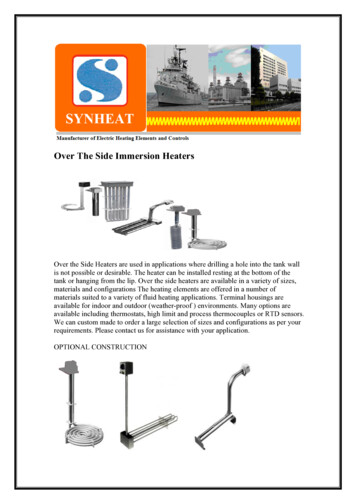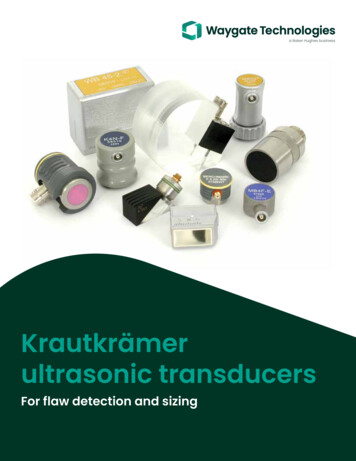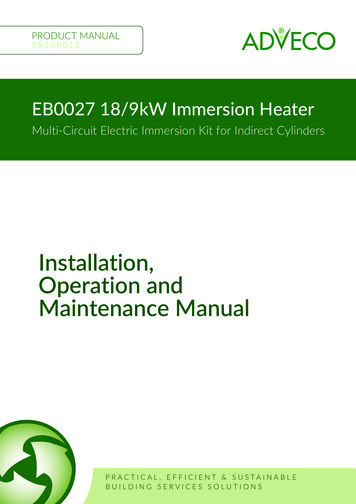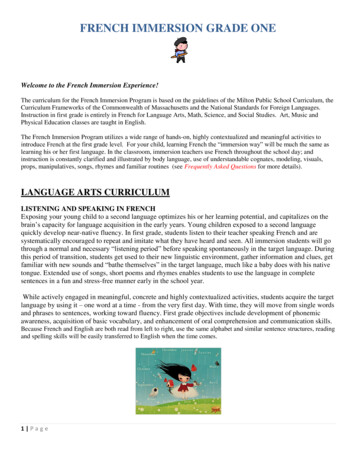
Transcription
GUIDELINES FOR WATER IMMERSIONAND WATER BIRTHNovember 20161
Information in this document is adapted from Texas Department of State Health Services.2
TABLE OF CONTENTSPageAcronyms .4Definition .5Water Birth Guidelines .7Recommended Criteria for the Use of Water Immersion .Contraindications for Entering the Pool .88Water Immersion .9Management of Second Stage .Management of Third Stage .Newborn Resuscitation .Reasons for Leaving the Pool .991010Pool Setup and Cleaning Recommendations .11Recommended Birth Pool and Components .Pools Not Recommended .Pools Management .Portable Pools .Non-portable Pools .Preparation Filling and Refilling the Pool .Depth and Temperature of Water .Quality Assurance .Birth Pool Documentation Logs .111111111213131314Midwife Safety .15Sources .163
ACRONYMSADHSAROMEPAPROMMCDPHArizona Department of Health ServicesArtificial Rupture of MembranesEnvironmental Protection AgencyPremature Rupture of MembranesMaricopa County Department of Public Health4
DEFINITIONSBiofilm: A thin, slimy film of bacteria that adheres to surfaces that is in regular contact withwater. This can develop in any place where there is water, especially stagnant water - in pipes,overflow drains, shower heads, jets, etc.Blackwater: Wastewater containing feces, urine and flush water from flush toilets, analcleansing water or toilet paper.Cleaning: The necessary first step of preparing the pools. The physical action of scrubbing withdetergents and surfactants and rinsing with water removes large numbers of microorganismsand debris from surfaces. If the surface is not cleaned before disinfecting, the process iscompromised.Components: Birth pool, pump, hose, adaptors, linersCritical Item: Any item that enters sterile tissue or the vascular system. If not sterile, there is ahigh possibility of infection. Example - needles and some instruments.Decontamination: Removes pathogenic microorganisms from objects so they are safe tohandle, use or discard.Disinfection: The necessary second step of preparing the pools to be used safely. A process thateliminates many or all pathogenic microorganisms on inanimate objects.Dwell Time: The amount of time a disinfectant must be in contact with a surface to kill themicrobes. All disinfectants are tested and labeled for the specific amount of time.Graywater: Wastewater streams generated from households or office buildings other than thewastewater from toilets. Sources of graywater include sinks, showers, baths, clothes washingmachines or dishwashers.Legionella: Legionella is a type of bacterium found naturally in freshwater environments. It canbecome a health concern when it grows and spreads in human-made water systems.Legionellosis: Legionellosis is a respiratory disease caused by Legionella bacteria. Sometimesthe bacteria cause a serious type of pneumonia (lung infection) called Legionnaires' disease.The bacteria can also cause a less serious infection called Pontiac fever that has symptomssimilar to a mild case of the flu.Non-critical Item: Any medical item that comes in contact with intact skin. Sterility of theseitems is not critical. For example - stethoscope, blood pressure cuff, etc.Pools: Considered part of a midwife’s equipment, but they are not a medical device.5
Sanitization: The process of cleaning and disinfecting.Semi-critical Item: Any medical item that comes in contact with mucous membranes or nonintact skin. Some bacteria present on these items will not be harmful. These items should becleaned and disinfected or discarded. For example - doppler, pool liner, pool.Water Immersion: A depth of water which ensures the mother’s belly and bottom to besubmerged fully in water while she sits or kneels. It is suggested that water immersion creates abuoyancy effect and produces hormonal changes which enhance labor. After approximately 30minutes, the body releases an increase of oxytocin which lasts approximately 90 minutes.6
WATER BIRTH GUIDELINESIn Arizona, approximately 1300 deliveries are facilitated by midwives each year. The exactnumber of water births is not known.In early 2016, Arizona experienced two legionellosis cases in infants, both after water births.Since these cases were confirmed cases of legionellosis within 10 days of birth, it suggests thatthese babies were exposed to Legionella through water during birth. After investigating thesetwo cases, infection prevention gaps were identified, indicating the need of education formidwives. Some gaps identified during the investigation include using a jetted Jacuzzi, andleaving the water in the birthing tub for a week at 980F. To increase the knowledge anddecrease the risk of Legionella, the Arizona Department of Health Services (ADHS) andMaricopa County Department of Public Health (MCDPH), along with the Licensed MidwifeAdvisory Committee, have taken this initiative to develop educational resources and guidelinesto assist Licensed Midwives conducting water births.Over the past decade, immersion in water for delivering the baby is becoming more popular inmany countries. Benefits of water immersion include increased relaxation, mobility, and painrelief. The safety of water immersion during labor has been established by research, and doesnot result in reduced APGAR scores, increased neonatal or maternal infections, or increasedNICU admissions (Cluett and Burns 2009). Several studies have shown that water births do notpose increased risks to mother or baby if properly planned and attended by a licensed careprovider (Deckker 2014, Young 2013, Demirel 2013). However, a few cases of neonatal infectionwith Legionella or other bacteria have been reported, but with proper use of pools can beminimized (Fritschel 2015). This guideline provides a review of information on labor and birth inwater to maximize the safety for women choosing the option of immersion in water for laborand/or birth.The aim of this guideline is to provide information on the use of water immersion for laborand/or birth. These recommendations are not intended to dictate an exclusive course ofmanagement or treatment. They must be evaluated with reference to an individual client'sneeds, resources and limitations unique to the place of birth and variations in client choices.It is recommended to discuss a water birth plan with patients prior to the onset of the labor andmake them aware of possible bacteria or other organisms that could be present in the water.The importance of following the midwife’s instructions properly regarding standing or leavingthe birth pool should be emphasized. The potential risks associated with birth in water such asaspiration of water by mom or baby, bacteria or illness, cord avulsion, and thermoregulation ofmom and baby should be addressed.7
This document can be used as a guide to address the benefits, risks and alternatives of waterimmersion during labor and birth.Recommended Criteria for the Use of Water Immersion Mother has elected and made an informed choice regarding water birth Single gestation at or 37 weeks who is low risk and within the midwife’s scope ofpracticeContraindications for Birthing in the Pool Any condition in the Arizona Midwifery Board Rules requiring transfer of care Presence of thick meconium Excessive intrapartum bleeding Elevated maternal temperature greater than 100.4 F (38 C) Non-reassuring fetal heart rate patterns The midwife’s ability to manage complications Active herpes, carrier of MRSA, or untreated skin infection should not enter the pool Rupture of membranes without active labor Use of agents producing sedation At the request of the client or the midwife’s discretion8
WATER IMMERSIONIt is best if the mother is in active labor, as assessed by the midwife, before the motherenters the water. If used during latent stage, pool should be disinfected and a new liner shouldbe used for active labor. A pool should not be used during latent labor in cases of PROM.Maternal vital signs and fetal heart rate should be monitored regularly as per standardof care and reevaluated after each change in water temperature. Since sitting in the pool can bedehydrating, the mother should be encouraged to remain hydrated, drinking water andelectrolytes. The mother should be encouraged to empty her bladder regularly on the toilet.Fecal matter or other contamination should be removed from the water immediately. If thewater becomes significantly contaminated, the mother should leave the pool unless birth isimminent.The midwife should prepare a safe birth environment outside the pool in caseevacuation of the birth pool is necessary, such as having towels and a blanket or mattress nearthe pool. Special attention should be provided to prevent slipping, and towels and/or a mopshould be nearby.Management of second stage of labor during water immersion Birth should be allowed to happen spontaneously with minimal stimulation of the fetalhead, including checking for a nuchal cord. The cord should never be clamped or cut while the head is still under water. If a tightcord delays the birth, the mother must stand or step out of the pool. Once the head is above the water, it must not be allowed to go back under the water. Infant’s head should be brought to the surface immediately after birth, taking care toprevent cord avulsion. The rest of the infant’s body should remain submerged topromote temperature regulation. If the cord is short, preventing the infant’s head from comfortably sitting above thewater, the mother may need to quickly vacate the pool.Management of third stage of labor during water immersion If bleeding is minimal, third stage may be managed in the pool. If the water becomes clouded with blood so that estimation of blood loss is not possible,the mother and infant should be quickly removed from the pool. Maternal vital signsand the mother’s emotional and physical response should also be considered in decisionto leave the pool.9
Newborn Resuscitation Waterborn babies may experience a slower transition in the first minutes postpartum. Be prepared for the possibility that it might be difficult to keep the newborn’s airwayopen and assure a good seal when resuscitating the infant while the mother is in thepool. The ventilations must be effective in order for them to work. Either have a firm surface nearby or have a CPR board with heating pad, towels andsaran wrap (for warmth) prepared near the pool. If mother can evacuate pool quickly, it may be possible to leave cord intact. If you have to move the infant, you will most likely have to cut the cord. Milking the cordfrom the introitus or base of placenta can be effective before cutting the cord. Follow NRP guidelines for compromised baby. Dry the baby’s face prior to mouth to mouth or bag/mask if needed.If contractions slow significantly or stop, the mother should leave the pool until labor iswell reestablished. If the midwife requests the mother exit the pool, the mother should complyand leave the pool immediately. If the midwife cannot auscultate fetal heart rate, the mothershould leave the pool. AROM should not be performed in the water, unless birth is imminent.Reasons why the midwife may ask the client to exit the water are given below:Reasons for Leaving the Pool Elevated maternal temperature or abnormal vital signs Slow progress, reduction in effective or frequency of contractions Non-reassuring fetal heart rate pattern or inability to adequately assess fetal heart rate Lack of descent during second stage Water temperature too hot or cold Fecal matter or other contamination that cannot be removed, unless birth is imminent Short umbilical cord Excessive bleeding Use of agents causing sedation At the request of the client or the midwife’s discretion10
POOL SETUP AND CLEANING RECOMMENDATIONSRecommended Birth Pools and Components Portable pools designed and manufactured for use as birth pools for which themanufacturer has provided cleaning and disinfecting instructions. These pools should beused with liners. Single-use disposable pools. Pools with removable jets and a pipeless system. The pool should be deep enough for water immersion.Pools Not Recommended Pools/tubs with piped recirculating water systems of any type that have heaters, jetsand/or overflow drains that cannot be easily cleaned. These features may harborbiofilms. Examples include Spa-in-a-Box, Soft Tub, and jetted tubs in client’s home. Client’s home baths are not recommended due to the presence of recirculating andheating systems in the tub as a place where biofilm develops If the client’s home bath is used for water labor or water birth, clean and disinfect thetub. A pool liner is highly recommended.Pool ManagementPortable PoolsSetting up Clean and disinfect the pool before installing the liner and after use. Use Environmental Protection Agency (EPA) approved tuberculocide disinfectants. Fill pool when midwife arrives or discuss with midwife to follow proper filling protocolFilling the Pool Allow the hot water to run for 3 minutes before filling the pool. This clears the hose andpipes of stagnant water and sediment. Do not use gray water or recycled water to fill the birth pool. Municipal water is generally considered safe if not left in the pool for more than 6hours.11
Well water is generally considered safe if not left in the pool for more than 6 hours.Make sure the water has been tested within the past year. If refilling the pool, use a newliner if there is visible contamination.Emptying the Pool Dispose of all debris - blood clots and feces.Use a submersible or external pump.Empty blackwater into toilet.Dispose of liner, debris net, etc.Clean and disinfect all semi-critical and non-critical items used in the birth pool,especially if they have come in contact with blackwater.Storage Store according to manufacturer’s instructions and where the pool will remain dry andfree of soil or other environmental debris.Non-portable PoolsSetting up Disinfect pool before filling. Use a disposable liner if you have a jetted pool. Run hot water for 3 minutes before filling the pool.Emptying the Pool Dispose of all debris - blood clots and feces - before it can flow into the drain pipe. Empty the pool every 6 hours. If you are going to refill the pool for the same client and there is visible contamination,clean and disinfect pool.Disinfecting the Pool Follow the CDC and/or manufacturers recommendations for disinfecting pool.o You can also use a 1:10 mix of chlorine bleach:water. The dwell time is 5 minutesto disinfect the pool. Because hypochlorites and other germicides are substantially inactivatedin the presence of blood, large spills of blood require that the surface becleaned before an EPA-registered disinfectant or a 1:10 (finalconcentration) solution of bleach is applied.o For current list of EPA-registered disinfectant, visit the EPA website.12
Clean and disinfect all semi-critical and non-critical items used in the birth pool,especially if they have come in contact with blackwater.Preparation, Filling, and Refilling the Pool The pool should be cleaned and disinfected as per the guidelines - Pool Setup andCleaning Recommendations. The midwife should direct the filling of the pool. The pool should not be filled beforeactive labor and the water should be changed after 6 hours. For portable tubs, a new, disposable liner should be used for each birth. It shouldremain unopened until pool is ready to be filled. A new unused potable water hose should be used each time the pool is filled. Hot water should be run from the tap for 3 minutes before connecting the hose andadding water to the pool. If well water is used to fill a pool, it should be tested by the Centers for Disease Control& Prevention (CDC) recommended Elite laboratory within 12 months of the EDD. The midwife should be able to easily reach the mother from at least two sides of thepool. No additives should be added to the water.Depth and Temperature of Water In order to facilitate the physiological response to water immersion and protect theinfant from being born in the air and resubmerging into water, the water mustcompletely cover the mother’s abdomen, but not reach to the level of her neck. The temperature of the water must be comfortable for the mother and below 100.4 F(38 C). This temperature is important to prevent maternal and fetal hyperthermia. Thewater temperature should be assessed before entry to the tub and after adding waterand documented in the chart.Quality Assurance The EPA recommends weekly flushing of the pipes by heating the water to 160 F andflushing for 30 minutes. Well water should be tested every year. Establish a way to monitor and log quality controls and staff performance for cleaningand disinfecting the pool.Recommended Cleaning Agents13
If a cleaning agent kills Mycobacterium tuberculosis, it should kill most if not allorganisms of concern, if used according to manufacturer’s instructions. Make surecleaning agent is compatible with pool material. See resources. Store cleaning agents according to manufacturer’s instructions.Birth Pool Documentation LogsCreate written evidence-based practice specific procedures for cleaning and maintaining birthpools according the recommendations in this document.Public HealthConsult with Public Health if a baby or mom becomes infected with a waterborne illness.Arizona County Contact eenleeLa PazMaricopaMohaveNavajoPimaPinalSanta CruzYavapaiYumaDay Time 20-375-7900928-771-3134928-317-4450After 77-202-0586928-442-5262928-317-462414
MIDWIFE SAFETYEach center should train all staff midwives and anyone involved in the use of water during laborand/or birth on all facility specific procedures developed for water birth and retain records ofemployee training. Some topics to include in training include the following, but are not limitedto: Use appropriate personal protective equipment as per CDC and OSHArecommendations. Any midwife or attendant with non-intact skin should cover the area. If the midwife hasa draining wound that cannot be contained, she should not attend a water birth or cleanthe pool afterward. Bath mats should not be used inside the pool. If the area surrounding the pool becomes wet, clean and disinfect the area. No electrical equipment to be used in or near where it could fall into the pool. Consider using good body mechanics such as not leaning over the edge of the pool forlong periods of time and using kneeling pads when necessary.15
SOURCESArizona Administrative Code Article 1. Licensing of Midwifery. Available at:http://apps.azsos.gov/public services/Title er B., – Water birth International (2006). Guideline for a Safe Water Birth. Available elines%20for%20safe%20Water%20use.pdfCluett, E., & Burns, E. (2009). Immersion In Water In Pregnancy, Labour, And Birth. CochraneDatabase Syst Rev., 317-317. Retrieved April 13, 2015.Evidence on the Safety of Water birth. Available at: http://evidencebasedbirth.com/waterbirth/Demirel G., Moraloglu O., Celik I.H., Erdeve O., Mollamahmutoglu L., Oguz S.S., Uras N., DilmenU., (2013) The effects of water birth on neonatal outcomes: a five-year result of a referraltertiary centre. European Review for Medical and Pharmacological Sciences 17:1395-1398Disinfection of Hot Tubs Contaminated with Legionella infection.pdfDuckett, MD, R., & Barratt, midwife, J. (2014). Guideline for Use of Water during Labour andBirth. Worcestershire NHS.EPAList of tuberculocide products: www.epa.gov/oppad001/list b tuberculocide.pdfList of disinfectants: d-epa-registereddisinfectantsFritschel E., Sanyal K., Threadgill H., Cervantes D.T., (2015) Fatal Legionellosis after Water Birth,Texas, USA, 2014. Emerging Infectious Diseases 21(1).Gilbert, R., & Tookey, P. (1999). Perinatal mortality and morbidity among babies delivered inwater. British Medical Journal, 319, 183-7. Retrieved nes for Environmental Infection Control in Health-care Facilities: Recommendations ofCDC and the Healthcare Infection Control Practices Advisory Committee. CDC Healthcare.www.cdc.gov/hicpac/pdf/guidelines/eic in hcf 03.pdfHarding, C., Munro, J., & Jokinen, M. (2012). Evidence Based Guidelines for Midwifery-Led Carein Labour: Immersion in Water for Labour and Birth. Royal College of Midwives.16
Ingelby RM, J. (2014). Water birth Guideline: The use of the pool during labour and delivery.East Cheshire NHS.Legionella and the Prevention of Legionellosis (WHO).www.who.int/water sanitation health/emerging/legionella.pdfMcIntosh, J. (2011). Guideline for the Management of Water Birth in the Community.Bridgewater Community Healthcare NHS.Nutter, CNM, DNP, MSN, E., Shaw-Battista, CNM, PhD, J., & Marowitz, CNM, DNP, A. (2014).Waterbirth Fundamentals for Clinicians. Journal of Midwifery and Women's Health, 59(3), 350354.Otigbah, C., Dhanjal, M., Harmsworth, G., & Chard, T. (2000). A retrospective comparison ofwater births and conventional vaginal deliveries. European Journal of Obstetrics & Gynecologyand Reproductive Biology, 91(1), 15-20.Schorn, CNM, MS, M., McAllister CNM, MA, J., & Blanco MD, J. (1993). Water Immersion andthe Effect on Labour. Journal of Nurse-Midwifery, 38(6), 336-342.Young K., Kruske S. (2013). How valid are the common concerns raised against water birth? Afocused review of the literature. Women and Birth, 26(2), 105-109.Zanetti-Daellenbach, R., Tschudin, S., & Zhong, X. (2006). Maternal and neonatal infections andobstetrical outcome in water birth. European Journal of Obstetrics & Gynecology andReproductive Biology, 134(1), 37-43.17
minimized (Fritschel 2015). This guideline provides a review of information on labor and birth in water to maximize the safety for women choosing the option of immersion in water for labor and/or birth. The aim of this guideline is to provide information on the use of water immersion for labor and/or birth.










